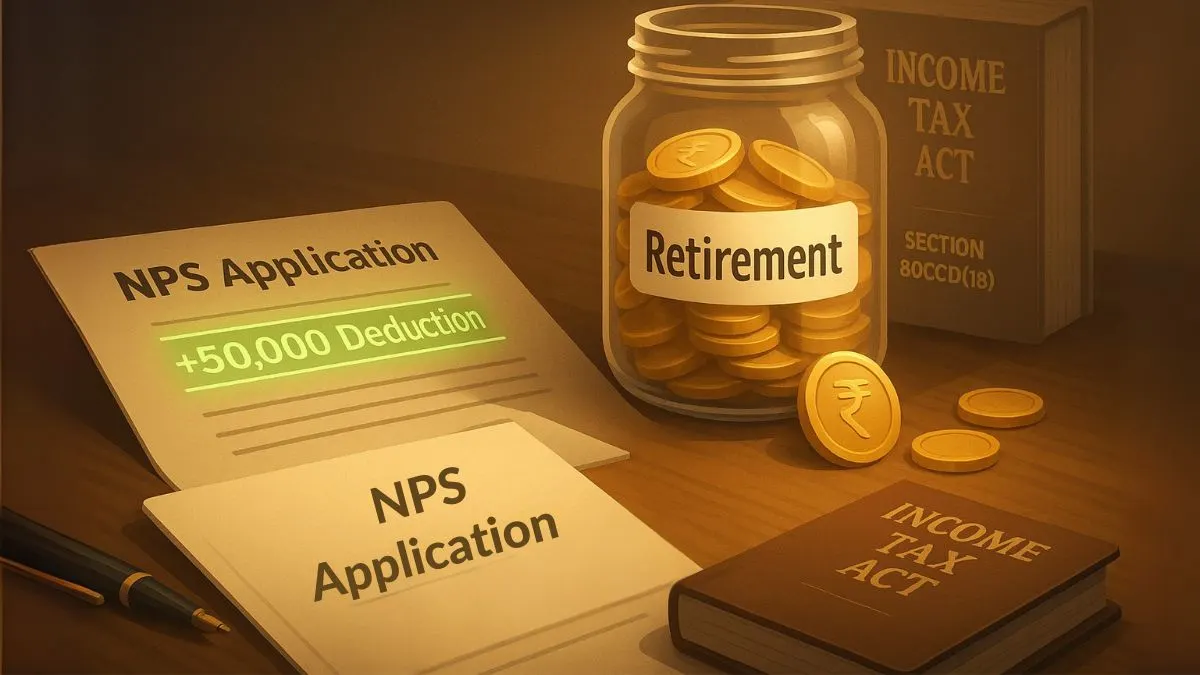
Tax-saving and retirement planning are two sides of the same coin. For most Indians, the government provides multiple tax deductions under the Income Tax Act, 1961 to encourage disciplined savings. Among these, one of the most beneficial provisions for salaried and self-employed individuals is Section 80CCD(1B) of Income Tax Act.
This section provides an additional deduction of ₹50,000 for contributions made to the National Pension System (NPS), over and above the limits available under Section 80C and Section 80CCD(1). The government introduced this provision to make NPS more attractive and to ensure citizens build a solid retirement corpus while enjoying immediate tax relief.
Let us understand in detail how Section 80CCD(1B) works, who can claim it, and why it is one of the most powerful tax-saving tools available.
What is Section 80CCD(1B)?
Section 80CCD(1B) was introduced in Union Budget 2015 with effect from AY 2016-17.
- It provides an additional deduction of up to ₹50,000 for contributions made to NPS over and above the deductions available under Section 80CCD(1), if the taxpayer chooses the old tax regime.
- This deduction is exclusive and separate from the ₹1.5 lakh limit under Section 80C.
- It is applicable to all NPS subscribers – both salaried & self-employed individuals.
In simple terms, if you have already maxed out your Section 80C investments (like PF, LIC, ELSS, tuition fees, etc.), you can still claim an extra tax deduction up to ₹50,000 under Section 80CCD(1B).
Key Features of Section 80CCD(1B)
- Eligibility: Any individual taxpayer who contributes to the NPS Tier I account.
- Deduction Limit: Provides an additional deduction of up to ₹50,000.
- Over and Above Section 80C: This benefit is over and above the ₹1.5 lakh limit under Section 80C.
- Old Tax Regime Only: The benefit is available only if the taxpayer chooses the old tax regime.
- NPS Tier I Contributions: Only deposits into Tier I NPS accounts qualify, not Tier II voluntary accounts.
This makes Section 80CCD(1B) a game-changer for individuals looking for both tax savings and retirement planning.
Also Read: Understanding NPS Income Tax Section: Save More, Stress Less!
Difference Between Section 80CCD(1) and Section 80CCD(1B)
- Section 80CCD(1): Part of Section 80C basket. Maximum deduction = ₹1.5 lakh. Contributions allowed up to 10% of salary (for salaried) or 20% of gross income (for self-employed).
- Section 80CCD(1B): Provides an additional deduction of ₹50,000 exclusively for NPS. This is separate & over the 80C limit.
For example:
If you invest ₹1.5 lakh in PPF, ELSS, and LIC → you already exhausted Section 80C."
If you additionally invest ₹50,000 in NPS → you can claim this under Section 80CCD(1B).
Total deduction = ₹2 lakh (₹1.5 lakh ₹50,000).
Example of Tax Savings
Let’s assume Mr. Sharma earns ₹10 lakh annually.
- He invests ₹1.5 lakh in LIC and PPF → Deduction under Section 80C.
- He contributes ₹50,000 to NPS → Deduction under Section 80CCD(1B).
Total tax deduction available = ₹2,00,000.
If he falls in the 30% tax slab, this saves him ₹60,000 tax (30% of ₹2 lakh).
Clearly, Section 80CCD(1B) provides a powerful tax advantage.
Why Was Section 80CCD(1B) Introduced?
The government wanted to:
- Promote NPS participation: NPS offers market-linked returns with lower charges.
- Encourage retirement planning: India lacks strong social security, so self-retirement planning is essential.
- Offer extra relief to middle-class taxpayers: Provides an exclusive tax benefit to all NPS subscribers.
Thus, by offering tax deduction up to ₹50,000 under Section 80CCD(1B), the government incentivized individuals to invest for long-term retirement security.
Also Read: Gift of tax relief on investment in NPS!
Benefits of Claiming Section 80CCD(1B)
- Exclusive Tax Benefit to NPS Subscribers u/s 80CCD(1B).
- Helps individuals go beyond the ₹1.5 lakh cap under Section 80C.
- Dual advantage – tax savings retirement corpus creation.
- Flexibility – both salaried and self-employed can avail.
- NPS investments also allow for partial withdrawals & annuity options.
Points to Remember
- Only individual taxpayers can claim – not HUFs or corporates.
- Applicable under old tax regime only.
- Investments must be in NPS Tier I account.
- Deduction is capped at ₹50,000 irrespective of income level."
- Contributions made for family members (like spouse or children) are not eligible under 80CCD(1B).
Long-Term Value of NPS
NPS not only saves tax but also builds wealth. Over decades, even small monthly contributions can create a significant retirement fund. Combining this with the exclusive Section 80CCD(1B) deduction makes it one of the smartest tax-planning tools available today.
Conclusion
Section 80CCD(1B) of Income Tax Act provides an additional deduction of up to ₹50,000 for contributions made to NPS over & above the deductions available under Section 80CCD(1), if taxpayers opt for the old tax regime. It offers an exclusive tax benefit to all NPS subscribers u/s 80CCD(1B) and ensures maximum savings.
If you are serious about both retirement planning and reducing taxes, this is one benefit you should not miss.
💡 Want expert help in maximizing your tax deductions and filing your return smoothly?
Get started with Callmyca.com – your trusted partner for tax planning and compliance.











